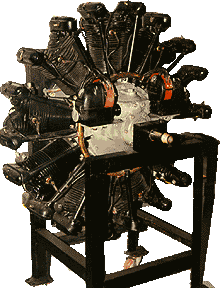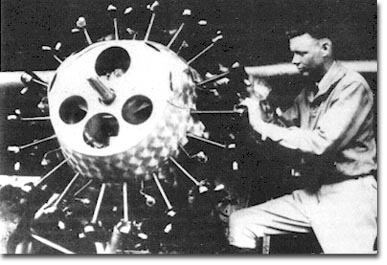
 |
Related Pages: |
When Wright Aeronautical was incorporated in 1919, its charter was the design and manufacture of aero engines. During the war, as Wright-Martin, they had done an outstanding job with the Hispano-Suiza, greatly improving its design, mastering its very difficult manufacture and even expanding the engine to a V-12.
The Wright brothers were no longer involved with the company. Wilbur had died, and Orville had other interests, but it can be said that Wright Aeronautical engine tradition began with the first Wright brothers' engine in 1903. In the early 1920's they were still building the Hisso in small quantities for military planes, a large 6-cylinder for Navy dirigibles and a 500 HP successor to the Liberty. Wright also made a tentative entry into the marine engine field. Manufacturing had moved to more modest facilities in Paterson, New Jersey.
The aero engine business was

|
Most engines of the period were water-cooled and suffered frequent cooling system failures. Radiators came apart; porous engine castings, lines, hoses and gaskets leaked. Failure rates were of great concern, particularly to the Navy where over-water flying was more hazardous. Wright did some work with air-cooled engines for the Army, but little came of this.
The Lawrance Aero Engine Corporation bore the name of its owner, Charles J. Lawrance, an engineer devoted to the development of air-cooled radial engines. He had started the development of a series of promising engine designs and demonstrated a working model to the Navy. The Navy quickly promoted a union between Lawrance and Wright, he providing technical leadership and Wright its formidable financial, engineering and manufacturing resources.
Wright bought his company and installed him as Chief Engineer, starting what would be their principal business for the next 40 years.
Lawrance's most advanced design was his model J-5, an engine that Wright undertook to fully develop.
Lawrance had the mechanical design of the J-5 right--but not cylinder head cooling. Radials had been built in England for some time, and air-cooled types and some viable designs were produced. Fortuitously, an Englishman, Samuel D. Heron, an engineer with wide experience in cooling English radials, was consulting at Wright Field at the time and was asked to help with the J-5. His redesign of cylinder head fin configuration made the engine a jewel.

|
The engine was the J-5C Whirlwind. It displaced 778 inches with 9 cylinders; was light at 510 lbs.; had no water-cooling appurtenances. It was simple and easily maintained; its cooling was so efficient that it could be operated with a lean air/fuel mixture, almost unheard of then, since rich mixtures were usually necessary to help cooling. The Whirlwind developed 220 HP at 1800 rpm, a low speed that contributed to its reliability.
It had one fault, which was not important or even recognized at the time--its large frontal area would produce excessive drag, but airplanes were slow then, and engine drag was not an important factor. Wright Aeronautical now had a first-class product and looked for a way to advertise the engine and show it to the world.
Guiseppe Bellanca was a Sicilian immigrant living with his brother in Brooklyn. He was an engineer whose passion was aerodynamics; he built an airplane in their backyard and taught himself to fly. Over several years he designed and built a line of airplanes, paying close attention to every detail of aerodynamics and streamlining. Fuselages were airfoil shapes producing lift (like today's lifting bodies); struts, braces and landing gear were carefully shaped. He calculated thin-wing airfoils that were years ahead of their time, carrying test samples from Brooklyn to Manhattan on the trolley to a wind tunnel at NYU.
His airplanes were strong and light, highly maneuverable and airworthy. Barnstorming pilots of the day itched to get their hands on a Bellanca. In the early 1920's Bellancas won more prizes at air meets than any other type.
Wright contracted with Bellanca to build an airplane tailored to the J-5C. The resulting machine, the Wright-Bellanca WB-2, is considered to be a benchmark airplane of American aviation. It was soon jointly flown by famous aviators Clarence Chamberlin and Bert Acosta and set new endurance records.
Charles A. Lindbergh was planning his solo flight, New York to Paris. He tried to buy the Bellanca but was considered to be an unreliable barnstormer. Instead the plane was sold to a New York businessman who planned to make the Paris flight together with Chamberlin as pilot. The plane was then named Columbia.
The Columbia was temporarily grounded over a legal hassle and lost the chance to be first. It made the flight shortly after Lindbergh with Berlin as its objective, but landed short because of bad weather, still outdistancing Lindbergh by about 300 miles.
Lindbergh's story is aviation history. He got his airplane from Ryan in San Diego, fitted with a J-5C. He was first and alone. Lindbergh's flight was an international triumph for Wright Aeronautical. Both Whirlwind engines never missed a beat.
Lindbergh's feat made the J-5C the most popular engine for long distance air travel. Soon more flights were made to Europe, to the North and South poles and across the Pacific with Whirlwind power.
Wrights' board of directors was content to rest on its laurels and bank the profits from burgeoning J-5 sales, but their engineers were already anxious to build the next radial in the 400 HP range. Reluctant to spend additional investment funds, Wright lost key engineering people who signed up with a machine shop in Hartford, CT, Pratt & Whitney, and put them in the engine business. Their first engine was another jewel, forcing Wright to compete, a competition that lasted until the introduction of the jet engine.
The J-5C Whirlwind was the progenitor of all the great radials that came afterwards.
On the surface, the future of the radial engine looked bright, but the airframers knew that if speeds were to increase, the problem of drag had to be addressed. Initially, since the engine was air-cooled, it seemed correct to place as much of it in the airstream as possible. The Ryan and Bellanca were built that way.
NACA systematically experimented with ways to reduce radial engine drag. They developed cowlings tailored to each engine and airframe that faired with the fuselage and smoothed airflow through and around the engine. These cowlings were also rudimentary ramjets, fueled by engine heat, producing a small thrust to help overcome drag.
Although radial-powered airplanes
would never be streamlined as well as their in-line counterparts, NACA
cowlings improved the performance of radial-powered airplanes sufficiently
to insure the future of the large radials to come.
Charles A. Lindbergh and the J-5C powered Spirit of St. Louis. The engine
was standard except for the replacement of 18 manually lubed rocker arms
grease fittings with automatic spring and plunger types. Courtesy of National
Air and Space Museum
[Reprinted with permission from the Curtiss-Wright Corporation. By William Wraga]
Privacy Policy | Terms and Conditions | This site is not affiliated with the Lindbergh family,
Lindbergh Foundation, or any other organization or group.
This site owned and operated by the Spirit of St. Louis 2 Project.
Email: webmaster@charleslindbergh.com
® Copyright 2014 CharlesLindbergh.com®, All rights reserved.
Help support this site, order your www.Amazon.com materials through this link.
